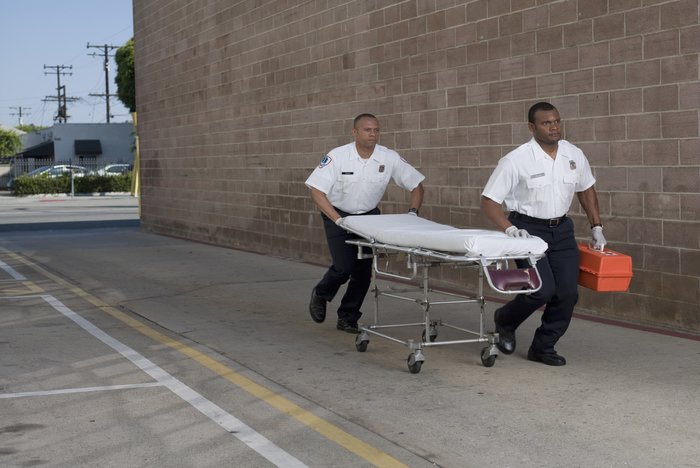
When you think about it, almost any call can devolve into a critical suction scenario. In EMS, you never know what you might face from one scene to another. Calls may sound benign on dispatch, yet when you arrive on scene, you're faced with something very different.
The key is to be prepared. That includes being fit and well-rested for duty, being up on your protocols and treatment strategies, and having the right equipment on hand when you need it. And no piece of equipment is more important than your respiratory emergency devices: namely, your portable suction unit.
So, to ensure you are prepared for any critical suction scenario, we're going to examine three key areas in which your portable suction unit will be needed. Let's begin with trauma.
1. Trauma Scenarios
According to the National Trauma Institute, traumatic injury is the number-one cause of death in individuals from the age of one year to the age of 46 years.1 That's more than cancer and heart disease combined. Trauma comes in many forms, from auto accidents to penetrating injuries (shootings and stabbings), any of which can lead to a critical suction scenario.
When responding to traumatic injuries, be sure to bring along your portable suction unit. The best way to ensure this happens is to have a unit small enough and portable enough to fit right into the trauma bag. There are multiple instances where suction is needed in the trauma scenario. They include:
- Facial trauma – Can lead to tissue, bone, teeth, and blood obstructing the airway
- Neck trauma – Which can affect the ability to swallow, leading to buildup of mucous in the airway
- Chest trauma – Damage to the lungs or chest wall can produce bloody froth, which can inhibit air movement, especially in the unconscious patient
For trauma calls, you must be sure to have an assortment of catheters on hand. The typical narrow-tipped catheter may not be sufficient for handling the debris of trauma. Keep an evacuation tool in the airway bag, to ensure you can handle even the most obstructed traumatic airway. And be sure you have a portable suction unit powerful enough to do the job.
2. Medical Scenarios Requiring Suction
Non-traumatic calls run the gamut. They can be anything from allergic reactions to COPD, and any medical call can result in a critical suction scenario. Let's look at three general conditions.
- Overdose: With heroin use on the rise, the number of patients overdosing has surged. And anytime you have an overdosed patient, no matter what the substance, you may end up with a critical suction scenario. Many overdosed patients are unable to protect their airway, and they become prime candidates for aspiration, obstruction, and death. To ensure you can handle any of these complications, be sure to bring the portable suction unit with you to every overdose call.
- Cardiac Arrest: Like any medical situation, cardiac arrest reversal will depend on a patent airway. And in most situations, a person in full arrest will require suction, not only to maintain patency but to assist with intubation. Visualizing the cords is impossible if the oral cavity is filled with mucous, blood, or vomit. Have someone assist with intubation by providing effective oral suctioning using your portable suction unit.
- Respiratory: Anytime you have the respiratory tract involved, think "portable suction unit!" Respiratory emergencies are especially susceptible to becoming critical suction scenarios, and the only way to maintain patency is to keep the airway clear.
Any medical scenario can turn critical, so include your portable suction unit with the rest of your ALS equipment. Better yet, stow the suction unit in the airway bag so that it is always there when needed.
3. Special Populations
Special populations require special consideration. From the outset, when responding to these patients, you must take into account their unique attributes. Here are three populations that may present critical suction scenarios.
- Pediatrics: In children, cardiac arrest is usually secondary to respiratory arrest, which means taking an aggressive approach to securing the airway. The smaller diameter of the pediatric airway, added to the delicacy of children’s oral tissues, means suctioning must be approached with caution but also with expedience. Use a smaller suction catheter, to prevent hypoxia and damage to the airway. Be sure to dial back the pressure when suctioning, to avoid overaggressive treatment.
- Geriatrics: Just as in children, elderly patients must also be approached cautiously when employing your portable suction unit. Like children, their oral and nasal tissues are delicate, leading to excessive bleeding when traumatized. Be alert for dental hardware when suctioning, because dentures, bridges, and loose teeth can become obstructions if dislodged. Use an appropriate size of catheter, based on the size of your patient, and consider reducing the pressure in these frailest of individuals.
- Special-Needs Patients: These patients can have an array of medical issues, any of which can turn into critical suction scenarios. The mentally and physically disabled present numerous challenges for EMS personnel and must be approached cautiously, taking into consideration the patient's history, disabilities, and presenting complaints. The patient may be dependent on machinery or adjuncts. He or she may have a respiratory device, such as a stoma, which requires special care. To help prevent a critical suction scenario, take a holistic approach to patient care, one that includes the patient’s unique situation. Keep an array of catheters on hand and employ some of the same cautious techniques as in pediatric or geriatric patients. Be ready for anything and be sure to keep the suction unit handy.
Being prepared for critical suction scenarios means having the right resources on hand. And the most important respiratory emergency device you depend on is your portable suction unit.
¹ 2015
Trauma Statistics & Facts, National Trauma Institute, https://www.nattrauma.org/what-is-trauma/trauma-statistics-facts/














